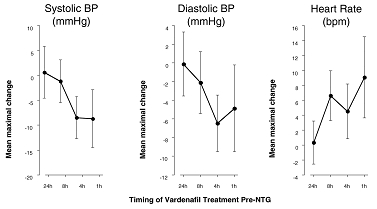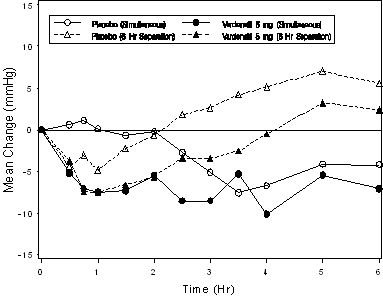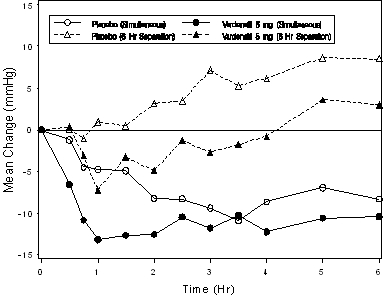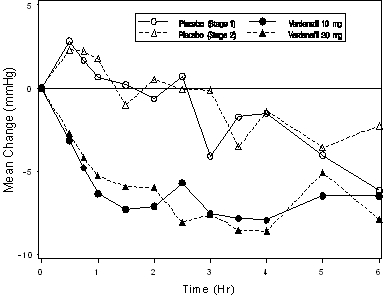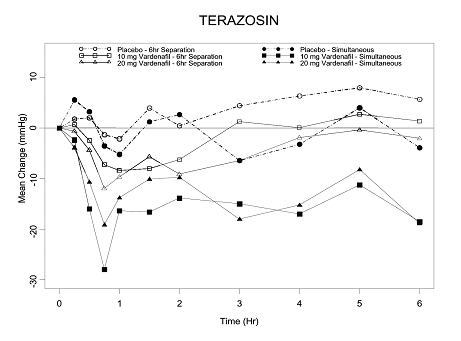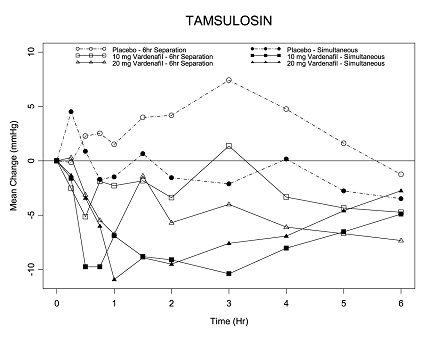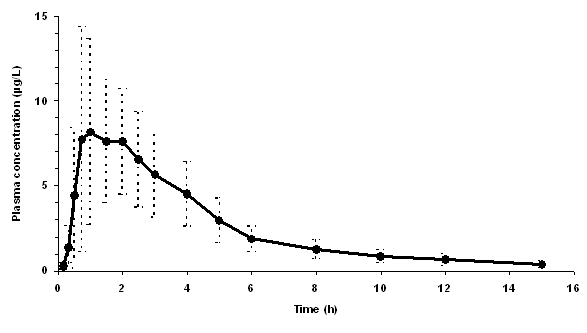STAXYN Tablet, orally disintegrating Ref.[11069] Active ingredients: Vardenafil
Source: FDA, National Drug Code (US) Revision Year: 2012
12.1. Mechanism of Action
Penile erection is a hemodynamic process initiated by the relaxation of smooth muscle in the corpus cavernosum and its associated arterioles. During sexual stimulation, nitric oxide is released from nerve endings and endothelial cells in the corpus cavernosum. Nitric oxide activates the enzyme guanylate cyclase resulting in increased synthesis of cyclic guanosine monophosphate (cGMP) in the smooth muscle cells of the corpus cavernosum. The cGMP in turn triggers smooth muscle relaxation, allowing increased blood flow into the penis, resulting in erection. The tissue concentration of cGMP is regulated by both the rates of synthesis and degradation via phosphodiesterases (PDEs). The most abundant PDE in the human corpus cavernosum is the cGMP-specific PDE5; therefore, the inhibition of PDE5 enhances erectile function by increasing the amount of cGMP. Because sexual stimulation is required to initiate the local release of nitric oxide, the inhibition of PDE5 has no effect in the absence of sexual stimulation.
In vitro studies have shown that vardenafil is a selective inhibitor of PDE5. The inhibitory effect of vardenafil is more selective on PDE5 than for other known phosphodiesterases (>15-fold relative to PDE6, >130-fold relative to PDE1, >300-fold relative to PDE11, and >1,000-fold relative to PDE2, 3, 4, 7, 8, 9, and 10).
12.2. Pharmacodynamics
The pharmacodynamic studies described below were conducted using vardenafil film-coated tablets.
Effects on Blood Pressure
In a clinical pharmacology study of patients with erectile dysfunction, single doses of vardenafil 20 mg film-coated tablets caused a mean maximum decrease in supine blood pressure of 7 mmHg systolic and 8 mmHg diastolic (compared to placebo), accompanied by a mean maximum increase of heart rate of 4 beats per minute. The maximum decrease in blood pressure occurred between 1 and 4 hours after dosing. Following multiple dosing for 31 days, similar blood pressure responses were observed on Day 31 as on Day 1. Vardenafil may add to the blood pressure lowering effects of antihypertensive agents [see Drug Interactions (7)].
Effects on Blood Pressure and Heart Rate when Vardenafil is Combined with Nitrates
A study was conducted in which the blood pressure and heart rate response to 0.4 mg nitroglycerin (NTG) sublingually was evaluated in 18 healthy subjects following pretreatment with vardenafil 20 mg film-coated tablets at various times before NTG administration. Vardenafil 20 mg caused an additional time-related reduction in blood pressure and increase in heart rate in association with NTG administration. The blood pressure effects were observed when vardenafil 20 mg was dosed 1 or 4 hours before NTG and the heart rate effects were observed when 20 mg was dosed 1, 4, or 8 hours before NTG. Additional blood pressure and heart rate changes were not detected when vardenafil 20 mg film-coated tablet was dosed 24 hours before NTG (see Figure 1).
Figure 1. Placebo-subtracted point estimates (with 90% CI) of mean maximal blood pressure and heart rate effects of pre-dosing with vardenafil 20 mg at 24, 8, 4, and 1 hour before 0.4 mg NTG subling ually:
Because the disease state of patients requiring nitrate therapy is anticipated to increase the likelihood of hypotension, the use of vardenafil by patients on nitrate therapy or on nitric oxide donors is contraindicated [see Contraindications (4.1)].
Blood Pressure Effects in Patients on Stable Alpha-Blocker Treatment
Two clinical pharmacology studies were conducted in patients with benign prostatic hyperplasia (BPH) on stable-dose alpha-blocker treatment for at least four weeks.
Study 1
This study was designed to evaluate the effect of 5 mg vardenafil film-coated tablets compared to placebo when administered to BPH patients on chronic alpha-blocker therapy in two separate cohorts: tamsulosin 0.4 mg daily (cohort 1, n=21) and terazosin 5 or 10 mg daily (cohort 2, n=21). The design was a randomized, double blind, cross-over study with four treatments: vardenafil 5 mg or placebo administered simultaneously with the alpha-blocker and vardenafil 5 mg or placebo administered 6 hours after the alpha-blocker. Blood pressure and pulse were evaluated over the 6-hour interval after vardenafil dosing. For blood pressure (BP) results, see Table 2. One patient, after simultaneous treatment with 5 mg vardenafil and 10 mg terazosin, exhibited symptomatic hypotension with standing blood pressure of 80/60 mmHg occurring one hour after administration and subsequent mild dizziness and moderate lightheadedness lasting for 6 hours. For vardenafil and placebo, five and two patients, respectively, experienced a decrease in standing systolic blood pressure (SBP) of >30 mmHg following simultaneous administration of terazosin. Hypotension was not observed when vardenafil 5 mg and terazosin were administered 6 hours apart. Following simultaneous administration of vardenafil 5 mg and tamsulosin, two patients had a standing SBP of <85 mmHg; two and one patient (vardenafil and placebo, respectively) had a decrease in standing SBP of >30 mmHg. When tamsulosin and vardenafil 5 mg were separated by 6 hours, two patients had a standing SBP <85 mmHg and one patient had a decrease in SBP of >30 mmHg. There were no severe adverse events related to hypotension reported during the study. There were no cases of syncope.
Table 2. Mean (95% CI) maximal change from baseline in systolic blood pressure (mmHg) following vardenafil 5 mg in BPH patients on stable alpha-blocker therapy (study 1):
| Alpha-Blocker | Simultaneous dosing of Vardenafil 5 mg and Alpha-Blocker, Placebo-Subtracted | Dosing of Vardenafil 5 mg and Alpha-Blocker Separated by 6 Hours, Placebo-Subtracted | |
|---|---|---|---|
| Terazosin 5 or 10 mg daily | Standing SBP | -3 (-6.7, 0.1) | -4 (-7.4, -0.5) |
| Supine SBP | -4 (-6.7, -0.5) | -4 (-7.1, -0.7) | |
| Tamsulosin 0.4 mg daily | Standing SBP | -6 (-9.9, -2.1) | -4 (-8.3, -0.5) |
| Supine SBP | -4 (-7, -0.8) | -5 (-7.9, -1.7) |
Blood pressure effects (standing SBP) in normotensive men on stable dose tamsulosin 0.4 mg following simultaneous administration of vardenafil 5 mg or placebo, or following administration of vardenafil 5 mg or placebo separated by 6 hours are shown in Figure 2. Blood pressure effects (standing SBP) in normotensive men on stable dose terazosin (5 or 10 mg) following simultaneous administration of vardenafil 5 mg or placebo, or following administration of vardenafil 5 mg or placebo separated by 6 hours, are shown in Figure 3.
Figure 2. Mean change from bas eline in standing systolic blood pressure (mmHg) over 6 hour interval following simultaneous or 6 hr separation administration of vardenafil 5 mg or placebo with stable dose tamsulosin 0.4 mg in normotensive BPH patients (study 1):
Figure 3. Mean chang e from baseline in standing systolic blood pressure (mmHg) over 6 hour interval following simultaneous or 6 hr separation administration of vardenafil 5 mg or placebo with stable dose:
Study 2
This study was designed to evaluate the effect of 10 mg vardenafil (film-coated tablets) (stage 1) and 20 mg vardenafil (film-coated tablets) (stage 2) compared to placebo, when administered to a single cohort of BPH patients (n=23) on stable therapy with tamsulosin 0.4 mg or 0.8 mg daily for at least four weeks. The design was a randomized, double blind, two-period, cross-over study. Vardenafil or placebo was given simultaneously with tamsulosin. Blood pressure and pulse were evaluated over the 6-hour interval after vardenafil dosing. For BP results see Table 3. One patient experienced a decrease from baseline in standing SBP of >30 mmHg following vardenafil 10 mg. There were no other instances of outlier blood pressure values (standing SBP <85 mmHg or decrease from baseline in standing SBP of >30 mmHg). Three patients reported dizziness following vardenafil 20 mg. There were no cases of syncope.
Table 3. Mean (95% CI) maximal change from baseline in systolic blood pressure (mmHg) following vardenafil 10 and 20 mg (film-coated tablets) in BPH patients on stable alpha-blocker therapy with tamsulosin 0.4 or 0.8 mg daily (study 2):
| Vardenafil 10 mg Placebo-subtracted | Vardenafil 20 mg Placebo-subtracted | |
|---|---|---|
| Standing SBP | -4 (-6.8, -0.3) | -4 (-6.8, -1.4) |
| Supine SBP | -5 (-8.2, -0.8) | -4 (-6.3, -1.8) |
Blood pressure effects (standing SBP) in normotensive men on stable dose tamsulosin 0.4 mg following simultaneous administration of vardenafil 20 mg or placebo, or following administration of vardenafil 20 mg or placebo separated by 6 hours are shown in Figure 4.
Figure 4. Mean change from bas eline in standing systolic blood pressure (mmHg) over 6 hour interval following simultaneous administration of vardenafil 10 mg film-coated tablet (stage 1), vardenafil 20 mg film-coated tablet (Stage 2), or placebo with stable dos e tamsulosin 0.4 mg in normotensive BPH patients (study 2):
Blood Pressure Effects in Normotensive Men After Forced Titration with Alpha-Blockers
Two randomized, double blind, placebo-controlled clinical pharmacology studies with healthy normotensive volunteers (age range, 45–74 years) were performed after forced titration of the alpha-blocker terazosin to 10 mg daily over 14 days (n=29), and after initiation of tamsulosin 0.4 mg daily for five days (n=24). There were no severe adverse events related to hypotension in either study. Symptoms of hypotension were a cause for withdrawal in 2 subjects receiving terazosin and in 4 subjects receiving tamsulosin. Instances of outlier blood pressure values (defined as standing SBP <85 mmHg and/or a decrease from baseline of standing SBP >30 mmHg) were observed in 9/24 subjects receiving tamsulosin and 19/29 receiving terazosin. The incidence of subjects with standing SBP <85 mmHg given vardenafil and terazosin to achieve simultaneously the amount of time at the maximum concentration in serum (Tmax) led to early termination of that arm of the study. In most (7/8) of these subjects, instances of standing SBP <85 mmHg were not associated with symptoms. Among subjects treated with terazosin, outlier values were observed more frequently when vardenafil and terazosin were given to achieve simultaneous Tmax than when dosing was administered to separate Tmax by 6 hours. There were 3 cases of dizziness observed with concomitant administration of terazosin and vardenafil. Seven subjects experienced dizziness mainly occurring with simultaneous Tmax administration of tamsulosin. There were no cases of syncope.
Table 4. Mean (95% CI) maximal change in baseline in systolic blood pressure (mmHg) following vardenafil 10 and 20 mg (film-coated tablets) in healthy volunteers on daily alpha-blocker therapy:
| Dosing of Vardenafil and Alpha-Blocker Separated by 6 Hours | Simultaneous dosing of Vardenafil and Alpha-Blocker | ||||
|---|---|---|---|---|---|
| Alpha-Blocker | Vardenafil 10 mg Placebo-Subtracted | Vardenafil 20 mg Placebo-Subtracted | Vardenafil 10 mg Placebo-Subtracted | Vardenafil 20 mg Placebo-Subtracted | |
| Terazosin 10 mg daily | Standing SBP | -7 (-10, -3) | -11 (-14, -7) | -23 (-31, 16)* | -14 (-33, 11)* |
| Supine SBP | -5 (-8, -2) | -7 (-11, -4) | -7 (-25, 19)* | -7 (-31, 22)* | |
| Tamsulosin 0.4 mg daily | Standing SBP | -4 (-8, -1) | -8 (-11, -4) | -8 (-14, -2) | -8 (-14, -1) |
| Supine SBP | -4 (-8, 0) | -7 (-11, -3) | -5 (-9, -2) | -3 (-7, 0) | |
* Due to the sample size, confidence intervals may not be an accurate measure for these data. These values represent the range for the difference.
Figure 5. Mean change from baseline in standing systolic blood pressure (mmHg) over 6 hour interval following simultaneous or 6 hr separation administration of vardenafil 10 mg and 20 mg (film-coated tablets) or placebo with terazosin (10 mg) in healthy volunteers:
Figure 6. Mean change from bas eline in standing systolic blood pressure (mmHg) over 6 hour interval following simultaneous or 6 hr separation administration of vardenafil 10 mg and 20 mg (film-coated tablets) or placebo with tamsulosin (0.4 mg) in healthy volunteers:
Effects on Cardiac Electrophysiology
The effect of 10 mg and 80 mg vardenafil, administered as film-coated tablets, on QT interval was evaluated in a single-dose, double-blind, randomized, placebo- and active-controlled (moxifloxacin 400 mg) crossover study in 59 healthy males (81% White, 12% Black, 7% Hispanic) aged 45–60 years. The QT interval was measured at one hour post dose because this time point approximates the average time of peak vardenafil concentration. The 80 mg dose of vardenafil (four times the highest recommended dose of the film-coated tablets) was chosen because this dose yields plasma concentrations covering those observed upon co-administration of a low-dose of vardenafil (5 mg) and 600 mg b.i.d. of ritonavir. Of the CYP3A4 inhibitors that have been studied, ritonavir causes the most significant drug-drug interaction with vardenafil. Table 5 summarizes the effect on mean uncorrected QT and mean corrected QT interval (QTc) with different methods of correction (Fridericia and a linear individual correction method) at one hour post-dose. No single correction method is known to be more valid than the other. In this study, the mean increase in heart rate associated with a 10 mg dose of vardenafil, administered as a film-coated tablet, compared to placebo was 5 beats/minute and with an 80 mg dose of vardenafil the mean increase was 6 beats/minute.
Table 5. Mean QT and QTc changes in msec (90% CI) from baseline relative to placebo at 1 hour post-dose with different methodologies to correct for the effect of heart rate:
| Drug/Dose | QT Uncorrected (msec) | Fridericia QT Correction (msec) | Individual QT Correction (msec) |
|---|---|---|---|
| Vardenafil 10 mg | -2 (-4, 0) | 8 (6, 9) | 4 (3, 6) |
| Vardenafil 80 mg | -2 (-4, 0) | 10 (8, 11) | 6 (4, 7) |
| Moxifloxacin* 400 mg | 3 (1, 5) | 8 (6, 9) | 7 (5, 8) |
* Active control (drug known to prolong QT)
Therapeutic and supratherapeutic doses of vardenafil and the active control moxifloxacin produced similar increases in QTc interval. This study, however, was not designed to make direct statistical comparisons between the drugs or the dose levels. The clinical impact of these QTc changes is unknown [see Warnings and Precautions (5)].
In a separate postmarketing study of 44 healthy volunteers, single doses of 10 mg vardenafil (film-coated tablet) resulted in a placebo-subtracted mean change from baseline of QTcF (Fridericia correction) of 5 msec (90% CI: 2,8). Single doses of gatifloxacin 400 mg resulted in a placebo-subtracted mean change from baseline QTcF of 4 msec (90% CI: 1,7). When vardenafil 10mg (film-coated tablets) and gatifloxacin 400 mg were co-administered, the mean QTcF change from baseline was additive when compared to either drug alone and produced a mean QTcF change of 9 msec from baseline (90% CI: 6,11). The clinical impact of these QT changes is unknown [see Warnings and Precautions (5.7)].
Effects on Exercise Treadmill Test in Patients with Coronary Artery Disease (CAD)
In two independent trials that assessed 10 mg (n=41) and 20 mg (n=39) vardenafil (film-coated tablets), respectively, vardenafil did not alter the total treadmill exercise time compared to placebo. The patient population included men aged 40–80 years with stable exercise-induced angina documented by at least one of the following: 1) prior history of myocardial infarction (MI), coronary artery bypass graft (CABG), percutaneous transluminal coronary angioplasty (PTCA), or stenting (not within 6 months); 2) positive coronary angiogram showing at least 60% narrowing of the diameter of at least one major coronary artery; or 3) a positive stress echocardiogram or stress nuclear perfusion study.
Results of these studies showed that vardenafil did not alter the total treadmill exercise time compared to placebo (vardenafil 10 mg vs. placebo: 433±109 and 426±105 seconds, respectively; 20 mg vardenafil vs. placebo: 414±114 and 411±124 seconds, respectively). The total time to angina was not altered by vardenafil when compared to placebo (10 mg vardenafil vs. placebo: 291±123 and 292±110 seconds; 20 mg vardenafil vs. placebo: 354±137 and 347±143 seconds, respectively). The total time to 1 mm or greater ST-segment depression was similar to placebo in both the 10 mg and the 20 mg vardenafil groups (10 mg vardenafil vs. placebo: 380±108 and 334±108 seconds; 20 mg vardenafil vs. placebo: 364±101 and 366±105 seconds, respectively).
Effects on Eye
Single oral doses of phosphodiesterase inhibitors have demonstrated transient dose-related impairment of color discrimination (blue/green) using the Farnsworth-Munsell 100-hue (FM-100) test and reductions in electroretinogram (ERG) b-wave amplitudes, with peak effects near the time of peak plasma levels. These findings are consistent with the inhibition of PDE6 in rods and cones, which is involved in phototransduction in the retina. The findings were most evident one hour after administration, diminishing but still present 6 hours after administration. In a single dose study in 25 normal males, vardenafil (film-coated tablets) 40 mg, twice the maximum daily recommended dose, did not alter visual acuity, intraocular pressure, fundoscopic and slit lamp findings.
In another double-blind, placebo-controlled clinical trial, at least 15 doses of 20 mg vardenafil were administered over 8 weeks versus placebo to 52 males. Thirty-two (32) males (62% of the patients) completed the trial. Retinal function was measured by ERG and FM-100 test 2, 6 and 24 hours after dosing. The trial was designed to detect changes in retinal function that might occur in more than 10% of patients. Vardenafil did not produce clinically significant ERG or FM-100 effects in healthy men compared to placebo. Two patients on vardenafil in the trial reported episodes of transient cyanopsia (objects appear blue).
Effects on Sperm Motility Morphology
There was no effect on sperm motility or morphology after single 20 mg oral doses of vardenafil film-coated tablets in healthy volunteers.
12.3. Pharmacokinetics
The pharmacokinetics of vardenafil and its M1 metabolite from STAXYN have been evaluated in healthy male volunteers (18–50 years) and in young (18–45 years) and elderly (≥65 years) erectile dysfunction patients. Studies have shown that STAXYN provides higher systemic exposure of vardenafil compared to vardenafil 10 mg film-coated tablets.
Absorption
Figure 7. Vardenafil Plasma Concentration (Mean ± SD) Profile for STAXYN in men age 18-45 years with erectile dysfunction:
The median time to reach Cmax (Tmax) in patients receiving STAXYN in the fasted state was 1.5 h [range: 0.75–2.5 h]. After administration of STAXYN to elderly (≥65 years) and young (18–45 years) patients with erectile dysfunction, mean vardenafil AUC was increased by 21 to 29%, respectively while mean Cmax was lower by 19% and 8%, respectively, in comparison to 10 mg vardenafil (film-coated tablets). In a study of healthy male volunteers (18–50 years), the mean Cmax and AUC of vardenafil from STAXYN were higher by 15% and 44%, respectively compared to 10 mg vardenafil film-coated tablets.
Vardenafil was not found to accumulate in plasma when STAXYN was dosed daily over ten days.
Effect of food
A high fat meal had no effect on vardenafil AUC and Tmax from STAXYN in healthy volunteers and reduced Cmax by 35%. Clinical trials for STAXYN were conducted without regard to meals. STAXYN can be taken with or without food.
Effect of water
When STAXYN was swallowed with water, the AUC of vardenafil was reduced by 29% and median Tmax was shortened by 60 minutes while Cmax was not affected. In clinical trials, dosing was done without water. STAXYN should be taken without liquid.
Distribution
The mean steady-state volume of distribution (Vss) for vardenafil is 208 L, indicating extensive tissue distribution. Vardenafil and its major circulating metabolite, M1, are highly bound to plasma proteins (about 95% for parent drug and M1). This protein binding is reversible and independent of total drug concentrations.
Following a single oral dose of 20 mg vardenafil film-coated tablet in healthy volunteers, a mean of 0.00018% of the administered dose was obtained in semen 1.5 hours after dosing.
Metabolism
Vardenafil is metabolized predominantly by the hepatic enzyme CYP3A4, with contribution from the CYP3A5 and CYP2C isoforms. The major circulating metabolite, M1, results from desethylation at the piperazine moiety of vardenafil. M1 is subject to further metabolism. The plasma concentration of M1 is approximately 26% that of the parent compound. This metabolite shows a phosphodiesterase selectivity profile similar to that of vardenafil and an in vitro inhibitory potency for PDE5 28% of that of vardenafil. Therefore, M1 accounts for approximately 7% of total pharmacologic activity.
Excretion
The mean terminal half-life of vardenafil in patients receiving STAXYN tablets varied between about 4–6 hours. The elimination half-life of the metabolite M1 is between 3 to 5 hours. After oral administration, vardenafil is excreted as metabolites predominantly in the feces (approximately 91–95% of administered oral dose) and to a lesser extent in the urine (approximately 2–6% of administered oral dose). Vardenafil is a high clearance drug with a plasma clearance of 56.4 L/h following intravenous administration.
Pharmacokinetics in Specific Populations
Pediatrics
STAXYN is not indicated for use in pediatric patients. Vardenafil trials were not conducted in the pediatric population.
Geriatrics
Vardenafil AUC and Cmax in elderly patients (65 years or older) taking STAXYN were increased by 39% and 21%, respectively, in comparison to patients aged 45 years and below [see Use in Specific Populations (8.5)].
Hepatic Impairment
In volunteers with mild hepatic impairment (Child-Pugh A), the Cmax and AUC following a 10 mg vardenafil (film-coated tablets) dose were increased by 22% and 17%, respectively, compared to healthy control subjects. In volunteers with moderate hepatic impairment (Child-Pugh B), the Cmax and AUC following a 10 mg vardenafil (film-coated tablets) dose were increased by 130% and 160%, respectively, compared to healthy control subjects. Vardenafil has not been evaluated in patients with severe (Child-Pugh C) hepatic impairment [See Dosage and Administration (2.3), Warnings and Precautions (5.8), and Use in Specific Populations (8.6)].
Renal Impairment
In volunteers with mild renal impairment (CLcr=50–80 mL/min), the pharmacokinetics of vardenafil were similar to those observed in a control group with normal renal function. In the moderate (CLcr=30–50 mL/min) or severe (CLcr<30 mL/min) renal impairment groups, the AUC of vardenafil was 20–30% higher compared to that observed in a control group with normal renal function (CLcr>80 mL/min). Vardenafil pharmacokinetics have not been evaluated in patients requiring renal dialysis [see Dosage and Administration (2.3), Warnings and Precautions (5.9), and Use in Specific Populations (8.7)].
13.1. Carcinogenesis, Mutagenesis, Impairment of Fertility
Carcinogenesis
Vardenafil was not carcinogenic in rats and mice when administered daily for 24 months. In these studies systemic drug exposures (AUCs) for unbound (free) vardenafil and its major metabolite were approximately 400- and 170-fold for male and female rats, respectively, and 21-and 37-fold for male and female mice, respectively, the exposures observed in human males given the maximum recommended human dose (MRHD) of 20 mg.
Mutagenesis
Vardenafil was not mutagenic as assessed in either the in vitro bacterial Ames assay or the forward mutation assay in Chinese hamster V79 cells. Vardenafil was not clastogenic as assessed in either the in vitro chromosomal aberration test or the in vivo mouse micronucleus test.
Impairment of Fertility
Vardenafil did not impair fertility in male and female rats administered doses up to 100 mg/kg/day for 28 days prior to mating in males, and for 14 days prior to mating and through day 7 of gestation in females. In a corresponding 1-month rat toxicity study, this dose produced an AUC value for unbound vardenafil 200 fold greater than AUC in humans at the MRHD of 20 mg.
14. Clinical Studies
The efficacy and safety of STAXYN were evaluated in two identical multi-national, randomized, double-blind, placebo-controlled trials (studies 1 and 2). STAXYN was dosed without regard to meals on an as-needed basis in men with erectile dysfunction (ED), many of whom had multiple other medical conditions. In both pivotal studies, randomization was stratified so that approximately 50% of patients were ≥65 years old. Primary efficacy assessment was by means of the Erectile Function (EF) Domain score of the validated International Index of Erectile Function (IIEF) Questionnaire and two questions from the Sexual Encounter Profile (SEP) dealing with the ability to achieve vaginal penetration (SEP2), and the ability to maintain an erection long enough for successful intercourse (SEP3). The primary endpoints were assessed at 3 months.
Study 1 evaluated 355 mainly European (Belgium, France, Germany, Spain, South Africa, and Netherlands) patients (mean age 61.9; 67% White, 4% Black, 3% Asian, 26% Unknown). The mean baseline EF domain scores were 13 for both placebo and STAXYN groups. Study 2 evaluated 331 mainly North American (USA, Canada, Mexico, and Australia) patients (mean age 61.7; 69% White, 5% Black, 4% Asian, 22% Hispanic). The mean baseline EF domain scores were 12 for STAXYN and 13 for placebo.
In both studies STAXYN demonstrated clinically meaningful and statistically significant improvements over placebo in all 3 primary efficacy variables (see Table 6).
Table 6. Change from Baseline for the Primary Efficacy Variables in Studies 1 and 2:
| Study 1 | Study 2 | |||||
|---|---|---|---|---|---|---|
| Placebo | STAXYN | p-value | Placebo | STAXYN | p-value | |
| EF Domain Score | (N=172) | (N=181) | (N=160) | (N=167) | ||
| Endpoint | 14 | 21 | 14 | 21 | ||
| Change from baseline | 1.6 | 8.7 | <.0001 | 1.5 | 8.5 | <.0001 |
| Insertion of Penis (SEP2) | (N=169) | (N=179) | (N=161) | (N=168) | ||
| Endpoint | 45% | 74% | 43% | 69% | ||
| Change from baseline | 6.9% | 35.9% | <.0001 | 4.8% | 30.8% | <.0001 |
| Maintenance of Erection (SEP3) | (N=164) | (N=178) | (N=160) | (N=168) | ||
| Endpoint | 26% | 65% | 27% | 60% | ||
| Change from baseline | 11.6% | 51.6% | <.0001 | 12.4% | 45.9% | <.0001 |
14.1 Other Vardenafil Clinical Trials Using Film-Coated Tablets
Patients with ED and Diabetes Mellitus
Vardenafil demonstrated clinically meaningful and statistically significant improvement in erectile function in a prospective, fixed-dose [10 and 20 mg vardenafil film-coated tablets], double-blind, placebo-controlled trial of patients with diabetes mellitus (n=439; mean age 57 years, range 33–81; 80% White, 9% Black, 8% Hispanic, and 3% Other).
Significant improvements in the EF Domain were shown in this study (EF Domain scores of 17 on 10 mg vardenafil and 19 on 20 mg vardenafil compared to 13 on placebo; p<0.0001).
Vardenafil significantly improved the overall per-patient rate of achieving an erection sufficient for penetration (SEP2) (61% on 10 mg and 64% on 20 mg vardenafil compared to 36% on placebo; p<0.0001).
Vardenafil demonstrated a clinically meaningful and statistically significant increase in the overall per-patient rate of maintenance of erection to successful intercourse (SEP3) (49% on 10 mg, 54% on 20 mg vardenafil compared to 23% on placebo; p<0.0001).
Patients with ED after Radical Prostatectomy
Vardenafil demonstrated clinically meaningful and statistically significant improvement in erectile function in a prospective, fixed-dose 10 and 20 mg vardenafil film-coated tablets, double-blind, placebo-controlled trial in post-prostatectomy patients (n=427, mean age 60, range 44–77 years; 93% White, 5% Black, 2% Other).
Significant improvements in the EF Domain were shown in this study (EF Domain scores of 15 on 10 mg vardenafil and 15 on 20 mg vardenafil compared to 9 on placebo; p<0.0001).
Vardenafil significantly improved the overall per-patient rate of achieving an erection sufficient for penetration (SEP2) (47% on 10 mg and 48% on 20 mg vardenafil compared to 22% on placebo; p<0.0001).
Vardenafil demonstrated a clinically meaningful and statistically significant increase in the overall per-patient rate of maintenance of erection to successful intercourse (SEP3) (37% on 10 mg, 34% on 20 mg vardenafil compared to 10% on placebo; p<0.0001).
© All content on this website, including data entry, data processing, decision support tools, "RxReasoner" logo and graphics, is the intellectual property of RxReasoner and is protected by copyright laws. Unauthorized reproduction or distribution of any part of this content without explicit written permission from RxReasoner is strictly prohibited. Any third-party content used on this site is acknowledged and utilized under fair use principles.
